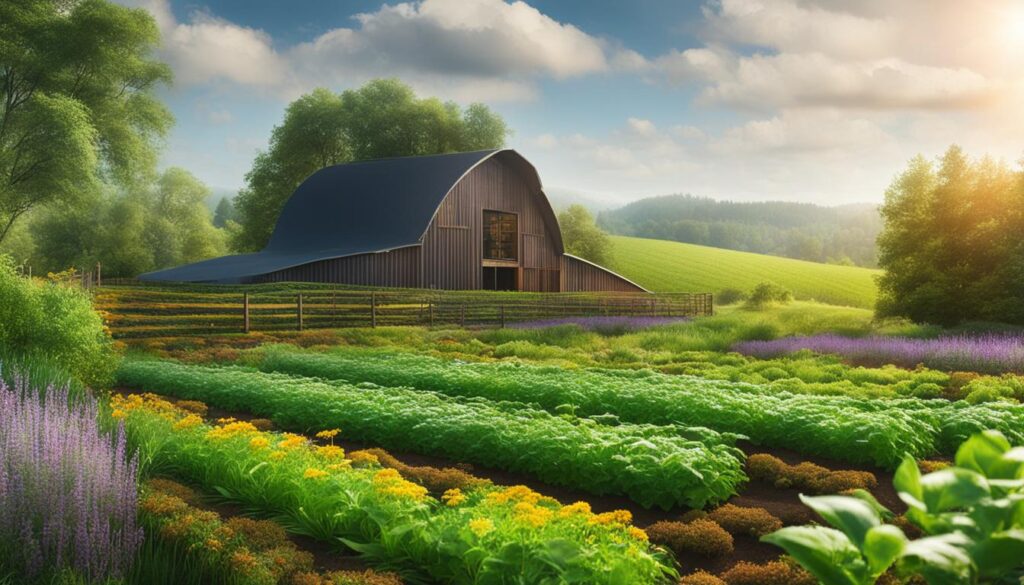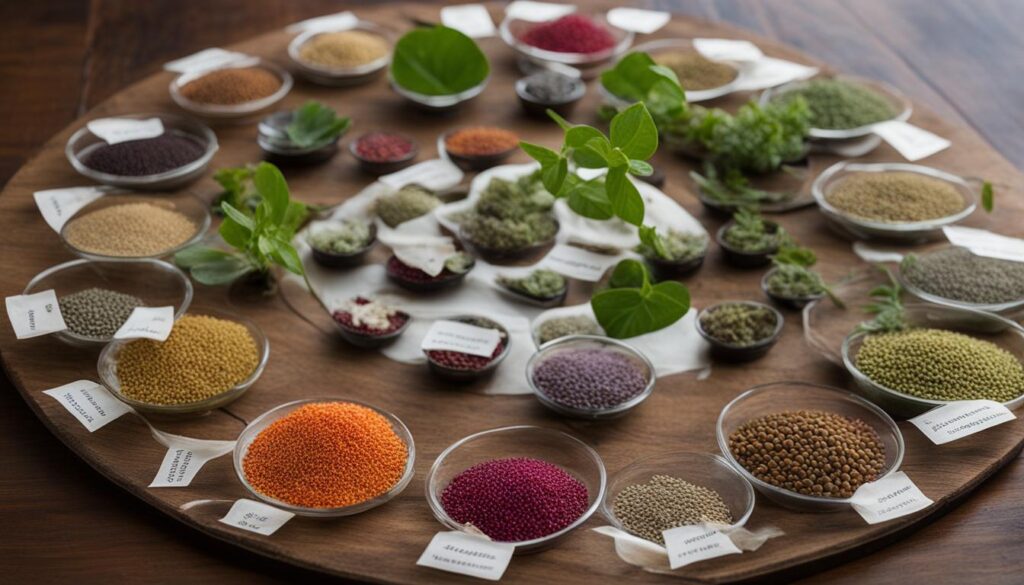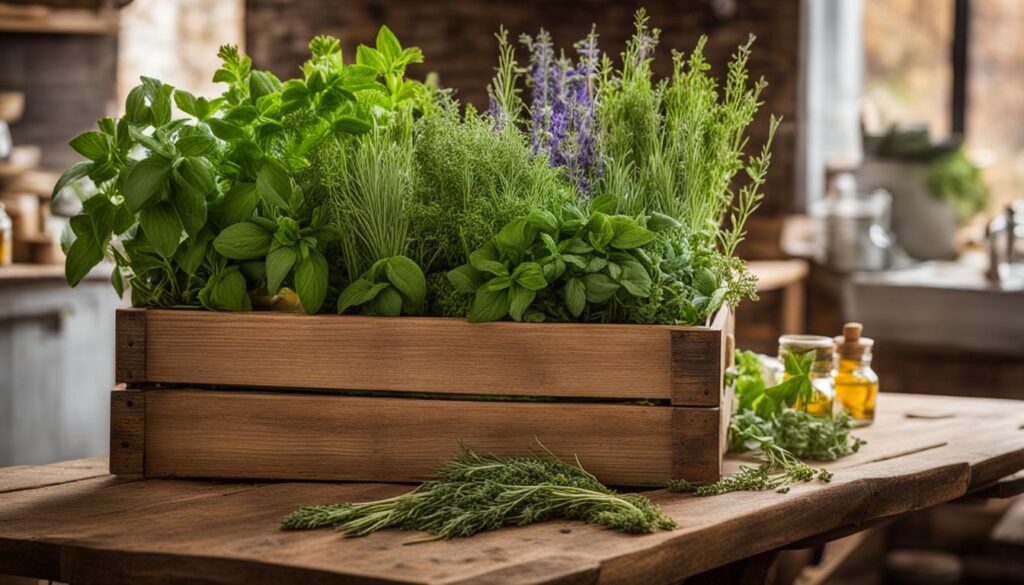Herbal farming is a rewarding practice that offers numerous benefits for both health and the environment. By adopting organic cultivation techniques and sustainable farming practices, herbal farmers can grow herbs in a way that is eco-friendly and promotes holistic health. These practices include proper site selection and field preparation, sourcing high-quality seed and rootstock, planting and growing with care, implementing pest control measures, and ensuring product quality through testing and practices. With these best practices, herbal farmers can cultivate herbs that are nourishing, medicinal, and ethical.
Natural Herb Cultivation: Key Steps for Successful Herbal Farming
When it comes to herbal farming, following a series of key steps is essential for success. These steps encompass various aspects, from site selection to regenerative agriculture practices, ensuring a holistic and sustainable approach to herb cultivation.
Site Selection
The first step in natural herb cultivation is choosing a suitable site for your farm. Consider factors such as soil quality, drainage, and access to water. Optimal growing conditions will contribute to the overall health and productivity of your herbs.
Organic Preparation and Planting
Prepare the field by incorporating organic matter into the soil and planting soil-building cover crops. This enriches the soil and promotes healthy root development. When it comes to planting, source high-quality seed and rootstock from reputable companies that offer varieties suitable for your intended purpose.
Care and Regenerative Practices
Proper care is crucial throughout the growth cycle of your herbs. Provide adequate irrigation and implement mulching to conserve moisture and control weeds. Additionally, consider regenerative agriculture practices, such as crop rotation and soil building, to promote long-term sustainability and soil health.
Pest Control and Quality Assurance
Implement natural pest control methods to protect your herbs without relying on harmful chemicals. Regular monitoring and proper identification of pests are essential. To ensure product quality, implement testing and quality assurance practices that meet industry standards.
By following these key steps for successful natural herb cultivation, herbal farmers can establish thriving and sustainable herb farms that contribute to a holistic approach to herbal farming.
Cultivation Techniques for Herb Farming
Cultivation techniques play a vital role in the success of herbal farming. As an herbal farmer, I have found that implementing permaculture principles and holistic herb production methods can lead to thriving and sustainable farms. By working with natural systems and creating a balanced ecosystem, we can grow herbs that are not only nourishing but also beneficial to the environment.
One of the key techniques in permaculture herb cultivation is companion planting. By interplanting different herbs and plant species, we can create a harmonious relationship where each plant supports the growth and health of the others. For example, planting aromatic herbs like lavender and rosemary alongside susceptible herbs can help repel pests and reduce the risk of disease.
“Companion planting is a time-tested technique that maximizes the potential of herbal crops. By strategically placing herbs together, we can create an environment where they thrive and support each other’s growth.” – Me
In addition to companion planting, natural pest control methods are crucial in holistic herb production. Instead of relying on synthetic pesticides, we can use organic pest control techniques such as introducing beneficial insects like ladybugs or using homemade sprays made from natural ingredients like neem oil. These methods not only protect our crops but also preserve the balance of the ecosystem.
Eco-Friendly Farming Methods for Sustainable Herb Production
When it comes to herbal farming, adopting eco-friendly farming methods is crucial for sustainable and holistic herb production. By prioritizing the health of the ecosystem and minimizing the use of chemical inputs, herbal farmers can create a harmonious relationship between their crops and the environment. Implementing regenerative agriculture practices and organic cultivation techniques not only benefits the herbs but also contributes to the overall well-being of the farming system.
One of the key principles of eco-friendly farming is using organic fertilizers and compost to nourish the soil. These natural inputs provide essential nutrients to the herbs and promote the growth of beneficial microorganisms in the soil. By avoiding synthetic fertilizers, herbal farmers can minimize the negative impact on the environment and create a healthier farming system.
Natural pest control methods are another important aspect of eco-friendly farming. By integrating biological control agents, such as beneficial insects or nematodes, herbal farmers can effectively manage pest populations without relying on chemical pesticides. This not only reduces the risk of pesticide residues in the herbs but also contributes to the preservation of beneficial insects and biodiversity in the farm.
Implementing eco-friendly farming methods in herbal farming is not just about minimizing negative impacts on the environment. It also goes hand in hand with holistic herb production, where the focus is on nurturing the overall health and well-being of the herbs and the surrounding ecosystem.
Additionally, practicing crop rotation and cover cropping can enhance soil health and biodiversity. Crop rotation helps break pest and disease cycles, improves soil structure, and prevents nutrient depletion. Cover cropping, on the other hand, provides soil cover, reduces erosion, and fixes nitrogen in the soil. These regenerative agriculture practices not only support the long-term sustainability of the farm but also contribute to the overall health and vitality of the herb plants.
Table: Comparison of Eco-Friendly Farming Methods
| Eco-Friendly Farming Methods | Benefits |
|---|---|
| Using organic fertilizers and compost | – Nourishes the soil – Minimizes the use of synthetic chemicals |
| Implementing natural pest control methods | – Reduces pesticide residues in herbs – Preserves beneficial insects and biodiversity |
| Practicing crop rotation and cover cropping | – Improves soil health and structure – Prevents pest and disease cycles – Enhances nutrient availability |
By embracing these eco-friendly farming methods, herbal farmers can promote sustainable herb production and contribute to a more environmentally friendly agricultural system. These practices not only benefit the herbs but also have a positive impact on the health of the soil, water, and surrounding ecosystem. By prioritizing holistic herb production and implementing regenerative agriculture practices, herbal farmers can cultivate herbs that are not only of high quality but also in harmony with nature.

Tips for Growing Medicinal Herbs
| Medicinal Herb | Key Considerations |
|---|---|
| Calendula |
|
| Lavender |
|
| Chamomile |
|
Growing medicinal herbs requires specific care and attention to ensure optimal potency and effectiveness. When cultivating these herbs, it is important to select varieties known for their medicinal properties and ease of cultivation. Proper care should be given to each herb, including providing the right growing conditions, timely harvesting, and appropriate storage methods.
One of the key considerations when growing medicinal herbs is to choose a suitable location and soil type. Each herb has specific requirements, such as full sun, well-drained soil, or partial shade. By meeting these requirements, you can ensure that the herbs receive the right amount of sunlight and moisture for optimal growth and potency.
Harvesting medicinal herbs at the correct time is crucial to capture their maximum medicinal properties. Each herb has a specific stage at which it is most potent, such as when the flowers are fully open or just beginning to open. Proper drying techniques should be employed to preserve the herbs’ potency, such as air-drying or using a dehydrator. Storing the herbs in airtight containers away from light and moisture will help maintain their quality and effectiveness.
Seed Saving and Propagation in Herbal Farming
Seed saving and propagation are essential skills for herbal farmers to maintain a sustainable and self-sufficient herb farm. By saving seeds and propagating plants, farmers can cultivate a diverse range of herbs without relying heavily on external seed suppliers. This not only reduces costs but also allows farmers to preserve and propagate heirloom varieties that may be unique to their region.
To ensure a successful seed-saving process, it is important to source seeds from reputable herbal seed suppliers. These suppliers specialize in providing high-quality medicinal seeds that are true to their variety and free from contaminants. When selecting seeds, it is beneficial to choose open-pollinated or heirloom varieties, as they are more likely to produce seeds that can be saved and replanted in future seasons.
“Seed saving and propagation are essential skills for herbal farmers to maintain a sustainable and self-sufficient herb farm.”
In addition to seed saving, herbal farmers can also propagate plants through root division. Root division involves carefully separating a portion of the plant’s root system and replanting it to grow a new herb plant. This technique is particularly useful for perennial herbs that have established root systems. By dividing the roots, farmers can multiply their herb harvest and expand their crop yield.
When practicing plant propagation, it is important to use proper techniques and tools. Sterilized cutting tools should be used to prevent the spread of disease, and the new plants should be carefully placed in well-prepared soil or growing medium. Providing the proper care and attention to the newly propagated plants will give them the best chance of survival and growth.

Tips for Successful Seed Saving and Plant Propagation:
- Source seeds from reputable herbal seed suppliers.
- Choose open-pollinated or heirloom varieties for seed saving.
- Practice proper seed storage techniques to maintain seed viability.
- Use sterilized cutting tools for root division and propagation.
- Prepare the soil or growing medium adequately before planting.
- Provide proper care and attention to newly propagated plants.
By mastering the art of seed saving and plant propagation, herbal farmers can create a sustainable and self-sufficient herb farm that thrives with a diverse range of herbs. These practices not only ensure the availability of high-quality seeds and plants but also contribute to the preservation of traditional herbal varieties and the long-term success of the herbal farming industry.
Harvesting and Storing Herbal Crops
Proper harvesting and storage techniques are crucial for maintaining the quality and potency of herbal crops. Harvesting herbs at the optimal time is essential to ensure that they have reached their peak potency. Care should be taken to harvest leaves and stems carefully, removing any dead or damaged parts. This ensures that only the freshest and healthiest parts of the plant are used.
Once harvested, herbs should be washed and dried properly to eliminate any dirt or moisture. Drying herbs is an effective method of preserving them for future use. Some herbs can be hung upside down in a cool, dry place to air dry, while others can be dried in a dehydrator. Ensuring proper ventilation during the drying process is important to prevent the growth of mold or bacteria.

Herbs can be stored in different forms, depending on personal preference and intended use. Dried herbs can be stored in airtight containers, away from direct sunlight, in a cool and dry place. Freezing herbs is another option, especially for herbs that retain their flavor and aroma when frozen. Herbal extracts, such as tinctures or oils, can be stored in dark glass bottles to protect them from light and retain their potency.
By following proper harvesting and storage techniques, herbal farmers can ensure that their herbs maintain their freshness, efficacy, and healing properties. Whether for personal use or commercial purposes, proper preservation techniques are vital to maximize the benefits of herbal crops.
Conclusion
Herbal farming practices encompass a holistic approach to herb cultivation, promoting both health and sustainability. By implementing organic cultivation techniques, herbal farmers can grow herbs in an eco-friendly manner, free from harmful chemicals. This not only ensures the production of nourishing and medicinal herbs but also contributes to a healthier environment.
Incorporating regenerative agriculture practices is another key aspect of herbal farming. Crop rotation, cover cropping, and soil building techniques help maintain the long-term health of the soil and promote biodiversity. By working with natural systems, herbal farmers can create self-sustaining and regenerative herb farms that benefit both the farmer and the ecosystem.
Adopting sustainable farming methods is crucial in herbal farming. By minimizing the use of chemical inputs and prioritizing organic fertilizers and compost, herbal farmers can protect the environment and preserve the integrity of their crops. Sustainable farming practices create a harmonious relationship between herbal crops and the ecosystem, ensuring a balanced and ethical approach to herb production.
In conclusion, herbal farming practices, which encompass organic cultivation techniques, regenerative agriculture practices, and sustainable farming methods, offer a blueprint for creating thriving and sustainable herb farms. By following these practices, herbal farmers can cultivate herbs that are not only nourishing and medicinal but also contribute to the well-being of the planet.
